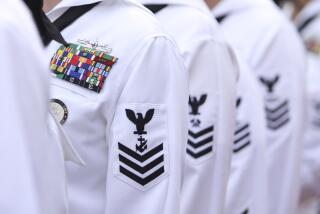Navy Tests Could Complicate Arms Talks
- Share via
WASHINGTON — The Navy, in a step that could complicate efforts to reach a new U.S.-Soviet strategic arms agreement and ultimately reduce the number of missile-firing U.S. submarines, has begun to test a larger number of nuclear warheads on its submarine-launched Trident 2 missiles, U.S. officials have confirmed.
The missile, which is to be deployed next year with eight warheads, was tested last month with the equivalent of 10 warheads and will be fired next month with the equivalent of 12. The current generation of Trident 1 missiles carries eight warheads.
The Soviets, in current talks aimed at setting ceilings on long-range missiles and the warheads they carry, have said that they want to count every new missile as if it were carrying the maximum number of warheads with which it has been tested.
The United States has not accepted or rejected this approach, which is the same as was used for the 1979 strategic arms limitation treaty. House Armed Services Committee Chairman Les Aspin (D-Wis.) has charged that Defense Secretary Caspar W. Weinberger sought tests of extra warheads to “throw sand in the works” of arms control talks.
Moreover, the Navy, whose reported opposition to testing the Trident 2 with more than eight warheads was apparently overridden by Weinberger, fears that it will be allowed fewer missile-launching submarines than it had sought. If 12 rather than eight warheads are allocated to each new missile, the Navy could get up to one-third fewer submarines than it wants.
The State Department as well as the Navy opposed tests with higher numbers, but Weinberger won his argument at the White House in August when the go-ahead was given for the September missile flight with nine warheads plus one test guidance package and for next month’s test of 11 warheads plus a test guidance package.
When the issue was presented to the White House, a senior Administration official said, “the arms control arguments against allowing for the test were not compelling enough to override the program manager (Weinberger) who wanted to test.”
Lighter Models Due
Weinberger, in a phone interview, said that his rationale for testing the Trident 2 with the larger number of warheads was “the same as for any weapon system: to test the system at its designed capacity to make sure it works.” He denied Aspin’s charge that he intended to confound the arms control negotiations.
The Trident 2, according to current Defense Department plans, is to carry eight new Mark-5 warheads in models that become operational in 1989 and 12 lighter Mark-4 warheads in models due after 1993. Critics argue that the tests with the larger number need not have been conducted so early, particularly with the United States and Soviet Union deep in negotiations on a new strategic arms agreement.
Weinberger said that the challenge to the tests “came from people who said, if you take the old counting rules in an old treaty (the 1979 pact) that was never adopted and is not now in effect, you may have problems. But such theoretical considerations were overridden by practical necessities” of following the testing program on a missile designed in 1981.
The 1979 agreement was to have remained in effect for five years, but was not ratified by the Senate. The Reagan Administration called it “fatally flawed” but abided by its provisions as long as the Soviets did the same until last year, when it declared the agreement “no longer in effect.”
Weinberger said that the previous counting rule was “silly . . . and also contrary to fact.” Many missiles, he said, carry fewer than the maximum warhead load with which they were tested because a lighter load means longer range and often increased accuracy. He urged that arms control agreements instead count the actual number of warheads on a missile.
More to Read
Sign up for Essential California
The most important California stories and recommendations in your inbox every morning.
You may occasionally receive promotional content from the Los Angeles Times.










